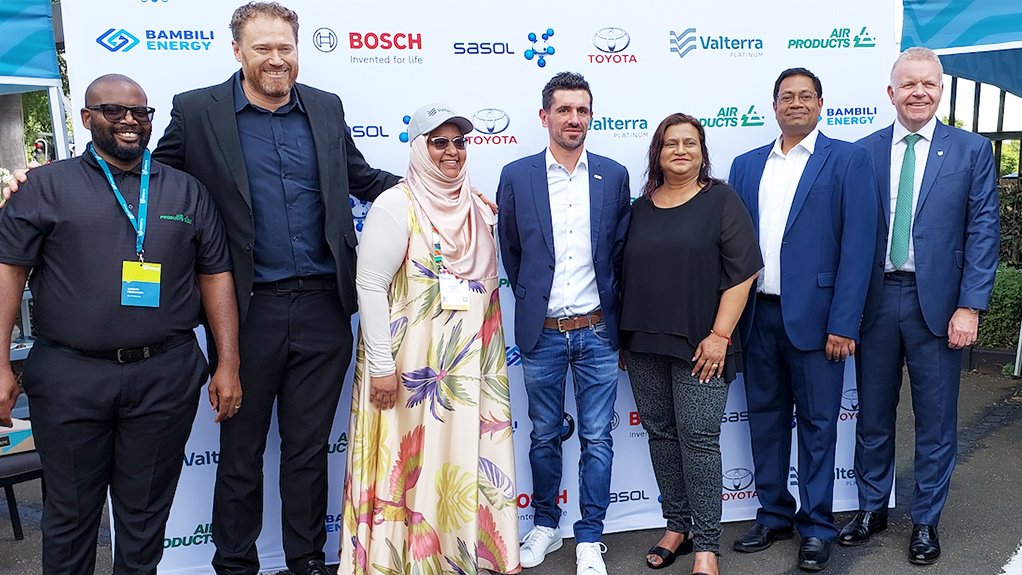JOHANNESBURG (miningweekly.com) – Mining Weekly as well several B20 visitors were this week chauffeured around Johannesburg in a platinum-catalysed hydrogen fuel cell electric vehicle (FCEV) that journalists attending South Africa’s B20 Summit witnessed being refuelled by Air Products with hydrogen from Sasol, and the full tank providing sufficient energy for a 500 km to 600 km journey. (Also watch attached Creamer Media video.)
Six companies were responsible for the impressive display of mine-to-market activation, which elevated the status of South Africa’s platinum group metals sky-high at a time of visiting B20 delegates.
The companies work collaboratively in a green mobility partnership that emphasises the local availability within South Africa of key ingredients needed to put FCEVs on the road at a time when South Africa's promising hydrogen corridor Project Rhynbow scheme is also progressing and South Africa and Japan have just signed a memorandum of cooperation on decarbonisation focused on South Africa becoming a green hydrogen and green ammonia supplier to Japan.
The Johannesburg Stock Exchange-listed Valterra Platinum, as an official sponsor of the B20 Summit, led the mine-to-market display at the Maslow Hotel in Sandton, amid an advertising hoarding that drew prominent attention to the vital contributions of Sasol, which has been producing hydrogen in major volumes in South Africa since 1950; Toyota, which provided the top-notch FCEV Mirai car that was used to chauffeur Mining Weekly on the low-noise drive around town; Air Products, which showed how refuelling speed is basically what we’re used to with petrol and diesel; Bambili Energy, the women-led local manufacturer of membrane electrode assemblies needed in fuel cells; Bosch, the German giant that makes use of the products made by Bambili; and BMW, which in February last year was the car company that laid on ‘sheer driving pleasure’ to the Mining Weekly team with its BMW iX5 FCEV taking journalists around Midrand.
While President Cyril Ramaphosa was outlining the extent to which the hydrogen economy unpacks major potential value for the South African economy, Valterra Platinum principal market development Fahmida Smith was reporting on FCEVs already giving taxi drivers a much longer range in Europe.
This followed Toyota new energy business development senior manager Anton Smalberger pointing out that “the best model we have is what we've seen in Europe”, a reference to the fleet of 200 FCEV taxis in Berlin.
“As Anton says, it does make economic sense, because it's giving the taxi drivers much longer range, and longer use of the vehicle,” Smith pointed out.
Instead of having a vehicle offline for a few hours while it recharges, the taxis come into a refuelling station and take a few minutes to refuel their FCEVs, giving them a lot more drive time.
“With that increase in drive time, they're able to then get to economies of scale. Within the South African context, we need to be cognisant that we don't have the large purse strings of Europe or the US or China, so we need to be very creative and innovative in how we do projects here, using the ecosystem approach,” a reference by Smith to the combination of Valterra with PGMs, Sasol with hydrogen, Air Products with hydrogen transport and refuelling, Toyota and BMW with FCEVs, Bosch with accomplished global implementation, and Bambili and potentially more local companies with contributing manufacture.
“For us, the ecosystem is important. With this type of mobile refueller, you can have a mobile system very quickly on the ground,” Smith remarked while standing alongside the mobile hydrogen dispenser provided by Air Products.
“As utilisation of the system increases, the price point decreases, and you can get to economies of scale a lot faster, eventually reaching the point of needing bulk infrastructure. You move away from the chicken-and-egg discussion and actively and innovatively drive a local hydrogen economy,” Smith explained.
Sasol business analyst low-carbon market development Vishal Subbaye drew attention to Sasol’s considerable forecourt presence in South Africa but cautioned that detailed studies on the co-location of hydrogen dispensing on these facilities could present challenges in some cases. But nonetheless, those studies are ongoing in the background, so there are opportunities to augment and scale.
“However, we have to be cognisant of the regulatory and the policy environments as well. What we see in the European Union as well in the United States and other regions of the world, is that there's policy alignment, there are regulatory alignments from environmental and safety perspectives, and then there are incentives,” Subbaye noted, to which Smalberger added: “It doesn’t just happen overnight. It needs a push.”
GREEN HYDROGEN CORRIDOR
South Africa’s green hydrogen corridor project, Project Rhynbow, which has been shortlisted for just energy transition investment, is a collaboration between Valterra Platinum, Bambili Energy, Sasol, and Total Energies, with Accenture as secretariat.
While this project is centred on the creation of a local hydrogen economy through heavy-duty mobility and stationary applications, it does include light passenger vehicles.
“Once that project is able to materialise, we will then have fixed infrastructure, but one that is also based on the same concept of fully contained refuellers, rather than bulk infrastructure, so it's a decentralised system,” said Smith, with Air Products projects and proposal manager Lutendo Mammburu explaining that Project Rhynbow runs along the N3 to Richards Bay, in KwaZulu-Natal.
“From our side, we've got a pipeline that crosses the N3 in Heidelburg, so it's hydrogen on tap and you don’t need to truck in hydrogen from anywhere. You are right on the pipeline that crosses the N3, which forms part of the consortium in terms of the route to the port,” Mammburu, who led the hydrogen dispensing activation, pointed out.
The role of Air Products in the concept of green hydrogen and mobility is supplying the technology. “We also supply the molecules from the source, which is then produced in Sasol. We’re the largest distributor of hydrogen in the country, including our pipeline and the fleet of trailers.
“We’ve now brought in a technology for vehicle refuelling that is mobile. We like to call it a hydrogen dispenser, because we are not refuelling, we are dispensing, and that's what we bring into the partnership. Compression also plays a part in hydrogen for mobility because you need pressure. At the moment, we’re at 380 bar and we’re working to get to 700 bar ultimate pressure,” Mammburu reported.
There is also a pilot that South Africa has embarked on through Hydrogen South Africa, or HySA. “We purchased a refueller from HySA. It was the first assembly of such equipment in South Africa, and it's engineering certified now as we speak, and we will install it, hopefully in the first quarter of next year at our offices, and then we'll have another launch,” Smalberger promised.
Asked by Mining Weekly to comment on the fuel cell membrane electrode assemblies from South Africa’s Bambili, Bosch Mobility Solutions Africa sales director Marillet Jean Philippe responded that he was not at liberty to disclose too much detail. “But I can say that we’re currently running with Bambili and discussion is underway between Bosch Germany and Bambili on the membrane electrode assemblies being used in our fuel cell technology for mobility applications.”
Bosch, which has a South African presence, offers wide-ranging technology which includes hydrogen fuel cells used in FCEVs.
Valterra succeeded in showcasing how raw materials from South Africa are impacting the cleaner, greener world, and how mining companies can work with local businesses able to create an ecosystem with high potential.
“This is a mine-to-market demonstration that is focused on localisation, inclusion and diversity, and that's the reason we have a company like Bambili Energy, which is a black female-owned company, a startup that is part of us that has ambition to manufacture fuel cells in-country.
“They are already making membrane electrode assemblies in-country. So, they take the South African-mined platinum, and they produce the membrane electrode assemblies in-country, which are already being sold globally.
“What we are trying to do through this ecosystem is to show that partnership, which is something that's so key in B20, and this inclusion, is so important for us to be able to get an ecosystem like this off the ground. We can't get this done alone. We need to work in partnership and as Valterra, we’re driving this collaboration at mine-to-market level,” Smith explained.
While Toyota’s Mirai is not commercially available in South Africa, mine-to-market activation reiterated Toyota’s global leadership in hydrogen technology and its alignment with the B20’s vision for innovative solutions that advance climate resilience and accelerate the energy transition.
Powered by hydrogen fuel cells, the Mirai emits only water vapour, exemplifying Toyota’s commitment to carbon neutrality.
The event supported the B20 Task Force on Energy, Sustainability and Climate's drive to achieve inclusive growth through clean energy solutions.
The showcase provided insights into the technology behind the Toyota Mirai and the role of hydrogen in future mobility. The live demonstration exemplified cross-sector collaboration, a key B20 principle to build the infrastructure and partnerships necessary for a resilient hydrogen ecosystem.
"We believe showcasing this technology is vital to stimulating dialogue and partnerships that will drive sustainable mobility both in South Africa and globally," Toyota South Africa Motors senior VP Leon Theron stated in a media release to Mining Weekly.
DECARBONISATION COMMITMENT
Interesting to report is that the South African government, led by Trade, Industry and Competition Minister Parks Tau and Electricity and Energy Minister Dr Kgosientsho Ramokgopa, has signed a memorandum of cooperation on debarbonisation with Japan Ambassador to South Africa Fumio Shimizu, who signed on behalf of the Japanese government.
What must be pointed out is that South Africa and Japan are collaborating on decarbonisation through a partnership focused on South Africa becoming a green hydrogen and green ammonia supplier to Japan.
Bilateral trade between South Africa and Japan totalled $7.5-billion in 2024.
EMAIL THIS ARTICLE SAVE THIS ARTICLE ARTICLE ENQUIRY FEEDBACK
To subscribe email subscriptions@creamermedia.co.za or click here
To advertise email advertising@creamermedia.co.za or click here












